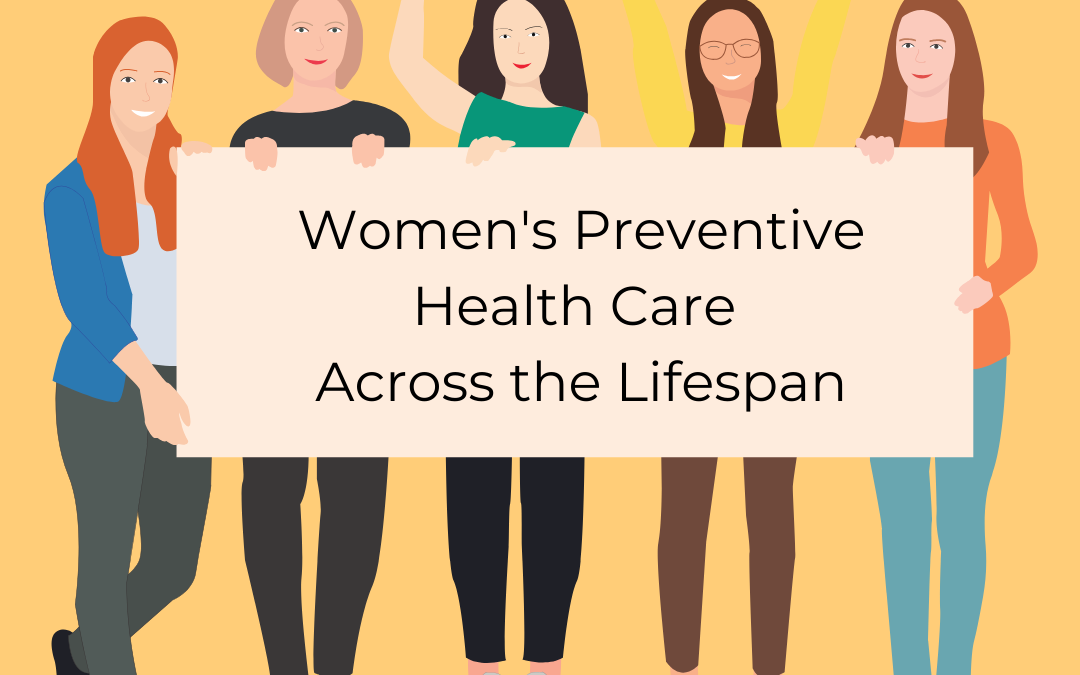The term women’s health covers more than just pap smears and mammograms. This category of healthcare has a wide scope covering care for people with a uterus from menstruation to pregnancy and osteoporosis, along with all of the health screenings in between. Women’s health aims at improving health over the lifespan with treatments and screenings beginning in the teen years and spanning the rest of a person’s life. The terminology for the women’s health category is evolving to recognize transgender and non-binary people. The women’s health category is inclusive for all people based on anatomy, not gender identity.
An Ounce of Prevention
One of the best things a person can do to take care of themselves is get routine screenings. Ideally, everyone should check in with their healthcare provider annually for a well check, but other screenings vary by age and circumstance. Routine health screenings serve to detect warning signs of potential health issues before they become serious problems. This allows the medical provider to work with the person on getting any needed treatment. Health screenings also help catch medical conditions early, which makes them easier to treat.
The typical preventative visit includes:
- Depression and suicide risk assessment.
- High blood pressure screening.
- Tobacco use screening and counseling for quitting. This includes vaping and chewing.
- Unhealthy alcohol use screening. The National Institute on Alcohol Abuse and Alcoholism recommends women have no more than seven drinks in a week and no more than three drinks in one day.
- Overweight or obesity assessment.
Additional Adolescent Screenings
Parents sometimes stop well-child checks when their kids become teens, but really they shouldn’t. When pre-teens begin noticing physical changes, a healthcare provider can help answer questions and discuss expectations for developing bodies. This is also the transition into adulthood with health screenings. All the above screenings become relevant. Additionally, the potential for sexual activity in teens also must be addressed. Things that may begin screening in adolescents:
- When someone becomes sexually active, they need screening for sexually transmitted diseases (STDs) at least once a year and with every partner change. In Oregon, chlamydia and gonorrhea are the most common STDs with syphilis on the rise.
- Counseling for STDs.
- Screening for the Human Immunodeficiency Virus (HIV).
- Screening for intimate partner violence is recommended at least once a year in women/persons of reproductive age.
- Contraception Counseling is recommended for anyone not seeking a pregnancy in the next year. Gender-affirming hormone therapy is not adequate for contraception.
Routine Women’s Health Screenings
As the transition into adulthood continues, so does the transition of screenings. Continue with annual health checks, and now add the pap smear, which screens for cervical cancer.
- Cervical cancer screening from age 21 to 65 years.
- Pap alone every three years in ages 21 to 29
- Over age 30 testing with pap smear and for high-risk human papillomavirus (HPV).
- Screening for diabetes in overweight or obese people who don’t have symptoms starting at age 35.
- Breast cancer screening for the average at-risk person beginning at age 40.
- Colorectal cancer screenings now start at age 45.
Pregnancy-specific screenings:
- Intimate partner violence screening remains important during pregnancy.
- Screening for hepatitis B at the first prenatal visit.
- Gestational diabetes screening and healthy weight gain counseling during pregnancy.
Older Adult
Older, wiser, and still getting health screenings. The older adult stops getting cervical cancer screenings after age 65 if they have been cancer free. STD screenings may continue as needed. A discussion with the healthcare provider may lead to discontinuation of colorectal and breast cancer screenings in 70 to 80-year-olds based on prior history and risk factors.
- Urinary incontinence screening. Women have come to believe incontinence is normal in aging. It is not.
- After menopause, osteoporosis becomes a risk due to the drop in hormones. Current screening guidelines recommend starting assessment at age 65 for average risk. Persons at higher risk, such as those with a family history of osteoporosis, begin screening at a younger age.
- Lung cancer screening for people with a 20-year smoking history.
Taking care of yourself remains the cornerstone in staying healthy to provide care to the ones you care about. Whether it is your husband, children, or dog. Check with your healthcare provider and stay up to date with your routine screenings.
To learn about preventive health across the life span, click HERE.
Resources:
The American College of Obstetricians and Gynecologists. (2021). Health Care for Transgender and Gender Diverse Individuals (Committee Opinion No. 823). https://www.acog.org/clinical/clinical-guidance/committee-opinion/articles/2021/03/health-care-for-transgender-and-gender-diverse-individuals
National Institute on Alcohol Abuse and Alcoholism. (2024) Rethinking Drinking. (NIH Publication No. 23-AA-3770). U.S. Department of Health and Human Services, National Institutes of Health. https://www.niaaa.nih.gov/sites/default/files/publications/NIAAA_RethinkingDrinking.pdf
Oregon Health Authority. (2024, June 11). Oregon’s Weekly Communicable Disease Report. https://public.tableau.com/app/profile/oregon.public.health.division.acute.and.communicable.disease.pre/viz/WeeklyCommunicableDiseaseReport/ACDPWeeklyReport
U.S. Preventive Services Task Force. (Accessed June 15, 2024). A & B Recommendations. https://www.uspreventiveservicestaskforce.org/uspstf/recommendation-topics/uspstf-a-and-b-recommendations
Health Resources & Services Administration. (2022) Women’s Preventive Services Guidelines. https://www.hrsa.gov/womens-guidelines-2016
Author: Leanna Coy, FNP-C, Family Nurse Practitioner and Health Content Writer

